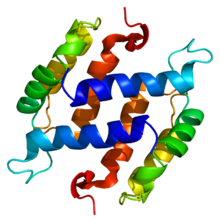
Back S-100-Proteine German Πρωτεΐνη S100 Greek Proteínas S100 Spanish Proteine S100 Italian Białka S-100 Polish Белок S100 Russian S100 Ukrainian S100蛋白 Chinese
| S100/ICaBP type calcium binding domain | |||||||||||
|---|---|---|---|---|---|---|---|---|---|---|---|
 Structure of the S100B protein. Based on PyMOL rendering of PDB 1b4c. | |||||||||||
| Identifiers | |||||||||||
| Symbol | S_100 | ||||||||||
| Pfam | PF01023 | ||||||||||
| InterPro | IPR013787 | ||||||||||
| PROSITE | PDOC00275 | ||||||||||
| SCOP2 | 1cnp / SCOPe / SUPFAM | ||||||||||
| |||||||||||
The S100 proteins are a family of low molecular-weight proteins found in vertebrates characterized by two calcium-binding sites that have helix-loop-helix ("EF-hand-type") conformation. At least 21 different S100 proteins are known.[1] They are encoded by a family of genes whose symbols use the S100 prefix, for example, S100A1, S100A2, S100A3. They are also considered as damage-associated molecular pattern molecules (DAMPs), and knockdown of aryl hydrocarbon receptor downregulates the expression of S100 proteins in THP-1 cells.[2]
- ^ Marenholz I, Heizmann CW, Fritz G (2004). "S100 proteins in mouse and man: from evolution to function and pathology (including an update of the nomenclature)". Biochemical and Biophysical Research Communications. 322 (4): 1111–22. doi:10.1016/j.bbrc.2004.07.096. PMID 15336958.
- ^ Memari B, Bouttier M, Dimitrov V, Ouellette M, Behr MA, Fritz JH, White JH (2015). "Engagement of the Aryl Hydrocarbon Receptor in Mycobacterium tuberculosis-Infected Macrophages Has Pleiotropic Effects on Innate Immune Signaling". Journal of Immunology. 195 (9): 4479–91. doi:10.4049/jimmunol.1501141. PMID 26416282.
© MMXXIII Rich X Search. We shall prevail. All rights reserved. Rich X Search